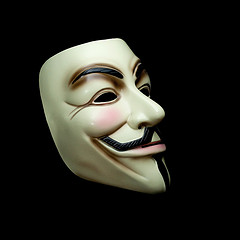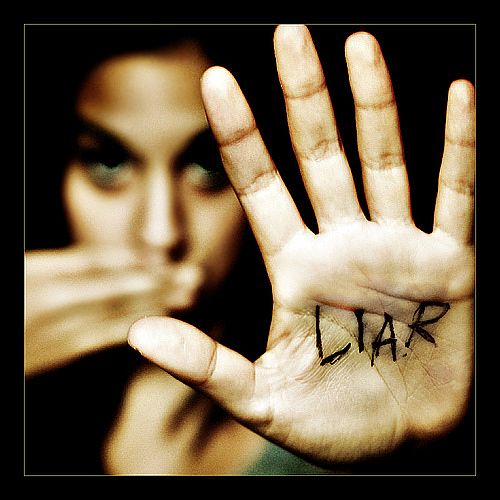Can you catch a Liar?
Reading Between the Lies - Identifying Concealed and Falsified Emotions in Universal Facial Expressions
by Stephen Porter and Leanne ten Brinke
According to Porter and ten Brinke (2008), "Modern humans are highly skilled deceivers," and "observers tend to perform at or slightly above chance in judging whether another person is lying (p. 508)." In their article, "Reading between the Lies -Identifying Concealed and Falsified Emotions in Universal Facial Expressions," the researchers mention that to facilitate deception, we alter or inhibit our facial expressions that usually accompany a particular emotion. We do this by utilizing three strategies (Porter & ten Brinke, 2008):

v
1. Simulating (expression unaccompanied by genuine emotion)
2. Masking (expression corresponding to the felt emotion is replaced by a falsified expression that corresponds to a different emotion)
3. Neutralizing (expression of a true emotion is inhibited while the face remains neutral)
v
Since the widespread belief that certain facial movements are beyond our conscious control has received very little empirical attention, Porter & ten Brinke set out to conduct the first comprehensive investigation of genuine and falsified facial expressions of emotion.
Participants viewed a timed slide show of photographs depicting a mix of highly positive, highly negative and neutral facial expressions and were asked to respond to each image with either a genuine or deceptive emotional expression (Porter & ten Brinke, 2008). Images were organized into sets (express disgust, happiness, sadness, fear, neutral) and contained 3 images each.
For example, in the happiness set, participants viewed 1 neutral, 1 happy, and 1 sad image and were asked to follow each with a convincing display of happiness. "Thus, in the case of the neutral photo, their happiness expression was simulated; in the case of the happy photo, their expression was genuine; and in the case of the sad image, their expression was masked (Porter & ten Brinke, 2008, p. 510)."
Results indicated that inconsistent expressions (incongruence between the emotion expressed and facial expression) occurred more frequently in masked than in genuine expressions, partially supporting Darwin's inhibition hypothesis. However, participants were largely successful in neutralizing their emotion. It thus appears to be more difficult to 'put on a mask' than to appear unemotional (Porter & ten Brinke, 2008).
Additionally, masking emotions led to higher blink rates in subjects, whereas neutralizing the face tended to lower blink rates. This knowledge may be of value when interviewing criminal suspects who, in attempting to appear credible, may over-control behavior and thus exhibit a decreased blink rate, instead of an increased blink rate (which has been assumed to be a sign of lying).
Overall, all subjects showed at least one inconsistent emotion, however, these displays varied in frequency and duration. This may indicate that certain emotions are more difficult to fabricate than others (Porter & ten Brinke, 2008). In addition, Porter and ten Brinke (2008) mentioned that inconsistent emotional displays that appeared during emotion falsification were rarely so brief as to be classified as micro expressions, according to Ekman's definition. Oftentimes, they lasted several times longer than expected, leading to the conclusion, that with training, inconsistencies in facial expressions may be easier to spot than previously thought (Porter & ten Brinke, 2008).
Can you catch a Liar?
Reading Between the Lies - Identifying Concealed and Falsified Emotions in Universal Facial Expressions
by Stephen Porter and Leanne ten Brinke
According to Porter and ten Brinke (2008), "Modern humans are highly skilled deceivers," and "observers tend to perform at or slightly above chance in judging whether another person is lying (p. 508)." In their article, "Reading between the Lies -Identifying Concealed and Falsified Emotions in Universal Facial Expressions," the researchers mention that to facilitate deception, we alter or inhibit our facial expressions that usually accompany a particular emotion. We do this by utilizing three strategies (Porter & ten Brinke, 2008):

v
1. Simulating (expression unaccompanied by genuine emotion)
2. Masking (expression corresponding to the felt emotion is replaced by a falsified expression that corresponds to a different emotion)
3. Neutralizing (expression of a true emotion is inhibited while the face remains neutral)
v
Since the widespread belief that certain facial movements are beyond our conscious control has received very little empirical attention, Porter & ten Brinke set out to conduct the first comprehensive investigation of genuine and falsified facial expressions of emotion.
Participants viewed a timed slide show of photographs depicting a mix of highly positive, highly negative and neutral facial expressions and were asked to respond to each image with either a genuine or deceptive emotional expression (Porter & ten Brinke, 2008). Images were organized into sets (express disgust, happiness, sadness, fear, neutral) and contained 3 images each.
For example, in the happiness set, participants viewed 1 neutral, 1 happy, and 1 sad image and were asked to follow each with a convincing display of happiness. "Thus, in the case of the neutral photo, their happiness expression was simulated; in the case of the happy photo, their expression was genuine; and in the case of the sad image, their expression was masked (Porter & ten Brinke, 2008, p. 510)."
Results indicated that inconsistent expressions (incongruence between the emotion expressed and facial expression) occurred more frequently in masked than in genuine expressions, partially supporting Darwin's inhibition hypothesis. However, participants were largely successful in neutralizing their emotion. It thus appears to be more difficult to 'put on a mask' than to appear unemotional (Porter & ten Brinke, 2008).
Additionally, masking emotions led to higher blink rates in subjects, whereas neutralizing the face tended to lower blink rates. This knowledge may be of value when interviewing criminal suspects who, in attempting to appear credible, may over-control behavior and thus exhibit a decreased blink rate, instead of an increased blink rate (which has been assumed to be a sign of lying).
Overall, all subjects showed at least one inconsistent emotion, however, these displays varied in frequency and duration. This may indicate that certain emotions are more difficult to fabricate than others (Porter & ten Brinke, 2008). In addition, Porter and ten Brinke (2008) mentioned that inconsistent emotional displays that appeared during emotion falsification were rarely so brief as to be classified as micro expressions, according to Ekman's definition. Oftentimes, they lasted several times longer than expected, leading to the conclusion, that with training, inconsistencies in facial expressions may be easier to spot than previously thought (Porter & ten Brinke, 2008).
Who Can Catch a Liar?
by Paul Ekman and Maureen O'Sullivan
Lies occur in nearly all areas of life and can have consequences that range from mild to severe for the deceiver and/or the person being deceived. When lies fail, they fail for many reasons; facts may be contradictory, third parties may betray the liars confidence or the liars demeanor may give him away (Ekman & O'Sullivan, 1991). When we are judging somones demeaner in hopes of uncovering whether or not they are telling the truth, we can make two errors:
- False Negative: liar is incorrectly judged to be truthful
- False Positive: person is incorrectly judged to be lying
- v
Many previous studies have supported the notion that our accuracy in detecting deceit is not much more than chance, leaving our chances of catching a lie without making a mistake rather slim. Ekman and O'Sullivan (1991), however, were not satisfied with these results. Their study was one of the first to use behavioral samples drawn from a set of videotaped interviews that during prior behavioral investigation showed differences in facial muscular movements and vocal pitch when subjects were lying (Ekman & O'Sullivan, 1991).
Subjects, which included members of the U.S. Secret Service, federal polygraphers, judges, police men, psychiatrists, other special interest groups and students, were asked to watch 10 one-minute samples taken from 10 videotaped interviews and to indicate whether each person they watched was honest or deceptive. The observer's accuracy scores could thus range from 0 (none correct) to 10 (all correct). Following the 2nd and the 8th video sample, subjects were also asked to indicate how they made their decision.
Results indicated that Secret service members performed significantly better than any other group, with 53% of the members scoring at or above 70% accuracy. The majority of members of other groups performed close to chnace level at 40-60% accuracy. Across the total sample, there was no relationship between accuracy in detecting deception and age, sex, or job experience (Ekman & O'Sullivan, 1991). Additionally, the study presents supporting evidence that more accurate lie catchers report using nonverbal as well as verbal clues to deceit, that they are better able to interpret subtle facial expressions (Ekman & O'Sullivan, 1991).
Overall, the study does not leave much hope for people like you and me in spotting deception, unless we continuously practice and raise our level of awareness for those subtle, fleeting expressions, that every now and then leak out all over our face and yell out 'liar'.
Who Can Catch a Liar?
by Paul Ekman and Maureen O'Sullivan
Lies occur in nearly all areas of life and can have consequences that range from mild to severe for the deceiver and/or the person being deceived. When lies fail, they fail for many reasons; facts may be contradictory, third parties may betray the liars confidence or the liars demeanor may give him away (Ekman & O'Sullivan, 1991). When we are judging somones demeaner in hopes of uncovering whether or not they are telling the truth, we can make two errors:
- False Negative: liar is incorrectly judged to be truthful
- False Positive: person is incorrectly judged to be lying
- v
Many previous studies have supported the notion that our accuracy in detecting deceit is not much more than chance, leaving our chances of catching a lie without making a mistake rather slim. Ekman and O'Sullivan (1991), however, were not satisfied with these results. Their study was one of the first to use behavioral samples drawn from a set of videotaped interviews that during prior behavioral investigation showed differences in facial muscular movements and vocal pitch when subjects were lying (Ekman & O'Sullivan, 1991).
Subjects, which included members of the U.S. Secret Service, federal polygraphers, judges, police men, psychiatrists, other special interest groups and students, were asked to watch 10 one-minute samples taken from 10 videotaped interviews and to indicate whether each person they watched was honest or deceptive. The observer's accuracy scores could thus range from 0 (none correct) to 10 (all correct). Following the 2nd and the 8th video sample, subjects were also asked to indicate how they made their decision.
Results indicated that Secret service members performed significantly better than any other group, with 53% of the members scoring at or above 70% accuracy. The majority of members of other groups performed close to chnace level at 40-60% accuracy. Across the total sample, there was no relationship between accuracy in detecting deception and age, sex, or job experience (Ekman & O'Sullivan, 1991). Additionally, the study presents supporting evidence that more accurate lie catchers report using nonverbal as well as verbal clues to deceit, that they are better able to interpret subtle facial expressions (Ekman & O'Sullivan, 1991).
Overall, the study does not leave much hope for people like you and me in spotting deception, unless we continuously practice and raise our level of awareness for those subtle, fleeting expressions, that every now and then leak out all over our face and yell out 'liar'.
-
Login:
-
(Logout)
More Than Meets the Eye


